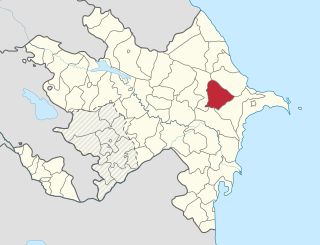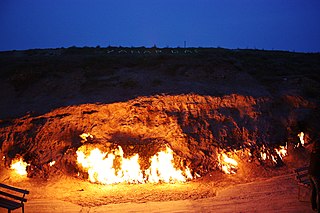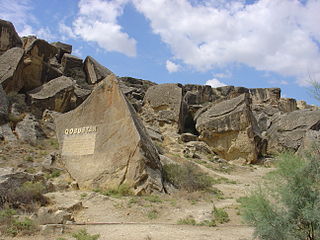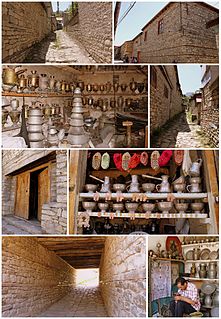| Qobustan | |
|---|---|
| Municipality | |
| Coordinates: 40°05′03″N49°24′57″E / 40.08417°N 49.41583°E Coordinates: 40°05′03″N49°24′57″E / 40.08417°N 49.41583°E | |
| Country | |
| City | Baku |
| Raion | Qaradağ |
| Population (2008) [1] | |
| • Total | 14,470 |
| Time zone | AZT (UTC+4) |
| • Summer (DST) | AZT (UTC+5) |
Qobustan (also, Duvannaya, Duvanny, Duvannyy, Duyannaya, and Gobustan) is a settlement and municipality in Baku, Azerbaijan.[ citation needed ] It has a population of 14,470.
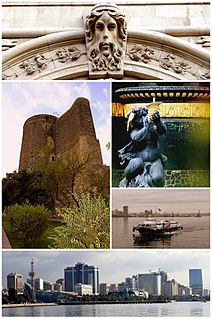
Baku is the capital and largest city of Azerbaijan, as well as the largest city on the Caspian Sea and of the Caucasus region. Baku is located 28 metres (92 ft) below sea level, which makes it the lowest lying national capital in the world and also the largest city in the world located below sea level. Baku lies on the southern shore of the Absheron Peninsula, alongside the Bay of Baku. At the beginning of 2009, Baku's urban population was estimated at just over two million people. Officially, about 25 percent of all inhabitants of the country live in Baku's metropolitan area. Baku is the sole metropolis in Azerbaijan.

Azerbaijan, officially the Republic of Azerbaijan, is a country in the South Caucasus region of Eurasia at the crossroads of Eastern Europe and Western Asia. It is bounded by the Caspian Sea to the east, Russia to the north, Georgia to the northwest, Armenia to the west and Iran to the south. The exclave of Nakhchivan is bounded by Armenia to the north and east, Iran to the south and west, and has an 11 km long border with Turkey in the northwest.
Contents
Qobustan is best known for being the home to the famous rock petroglyphs and mud volcanoes.
The area has been settled since the 8th millennium BC. It is known for hosting thousands of rock engravings spread over 100 square km depicting hunting scenes, people, ships, constellations and animals. Its oldest petroglyphs date from the 12th century BC. In 2007, UNESCO included the 'Gobustan Rock Art Cultural Landscape' in the World Heritage list. [2] The Gobustan State Reserve was featured during the Thirty-third Session of the Islamic Conference of Foreign Ministers. [3]

Petroglyphs are images created by removing part of a rock surface by incising, picking, carving, or abrading, as a form of rock art. Outside North America, scholars often use terms such as "carving", "engraving", or other descriptions of the technique to refer to such images. Petroglyphs are found worldwide, and are often associated with prehistoric peoples. The word comes from the Greek prefix petro-, from πέτρα petra meaning "stone", and γλύφω glýphō meaning "to carve", and was originally coined in French as pétroglyphe.

The United Nations Educational, Scientific and Cultural Organization is a specialized agency of the United Nations (UN) based in Paris. Its declared purpose is to contribute to peace and security by promoting international collaboration through educational, scientific, and cultural reforms in order to increase universal respect for justice, the rule of law, and human rights along with fundamental freedom proclaimed in the United Nations Charter. It is the successor of the League of Nations' International Committee on Intellectual Cooperation.

There are inscriptions nearby left by a Roman Legionnaire around 75AD during the reign of Emperor Domitian which is the eastern-most Roman inscription ever found. Gobustan is also famous for its mud volcanoes. [2] Nearly 300 of the world's 700 mud volcanoes are located in this part of eastern Azerbaijan near the Caspian Sea. [4]


